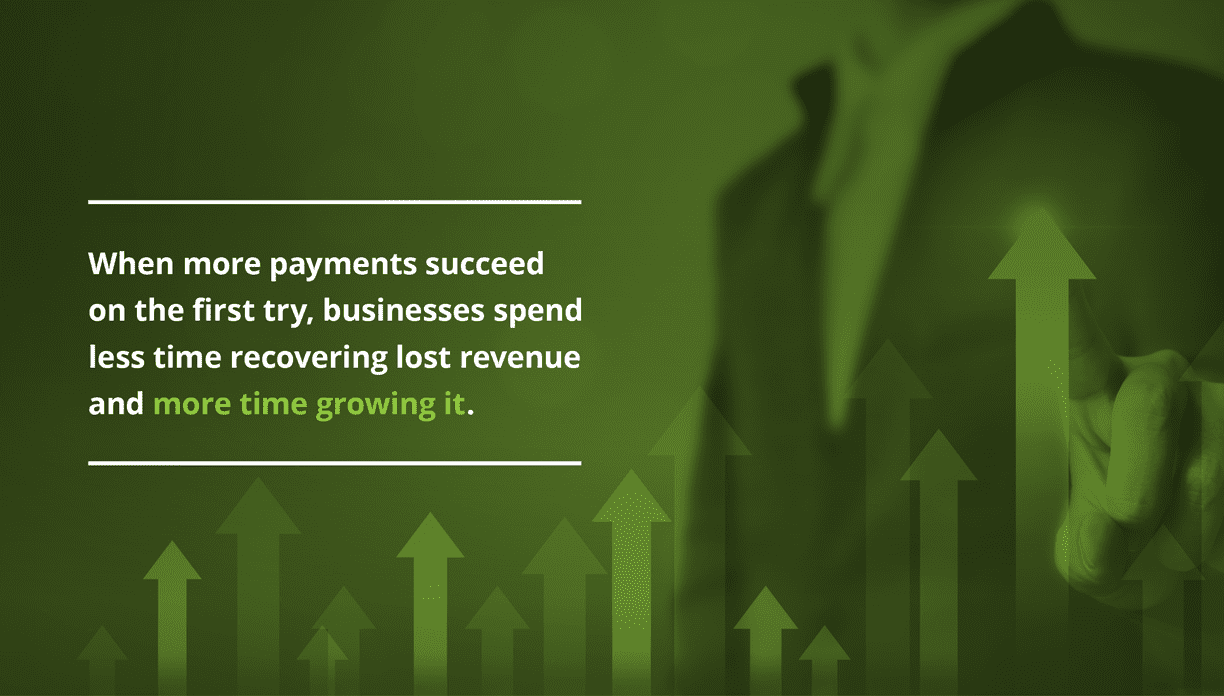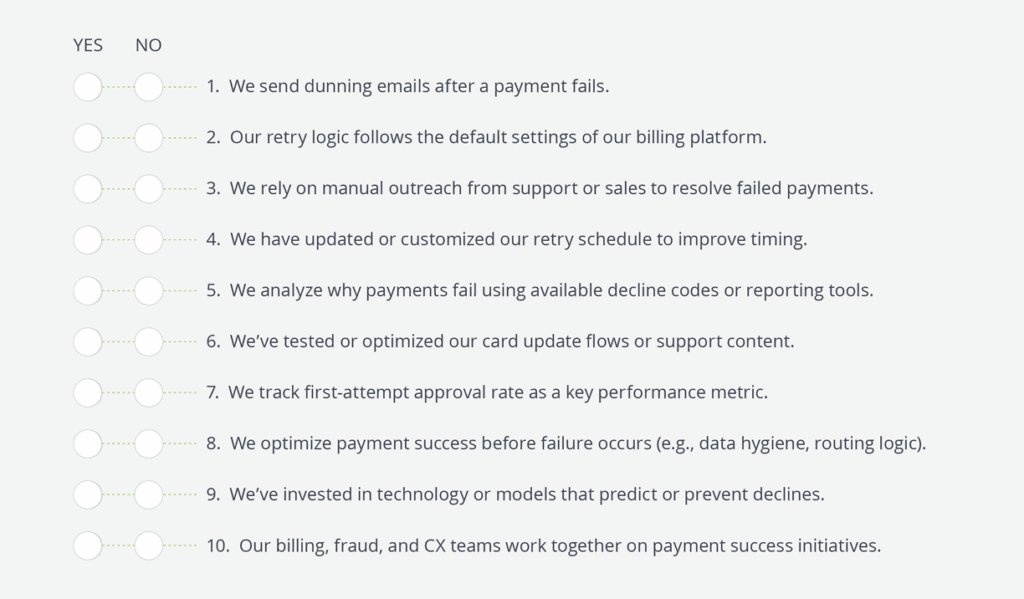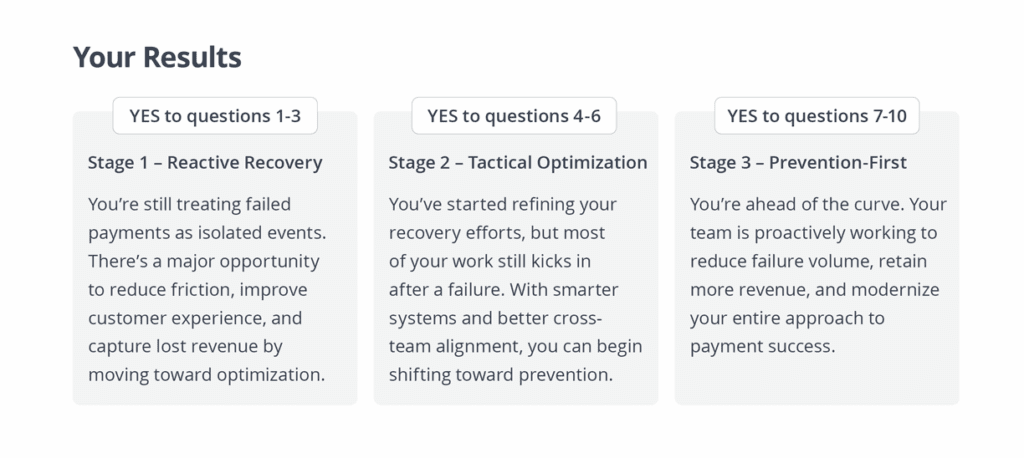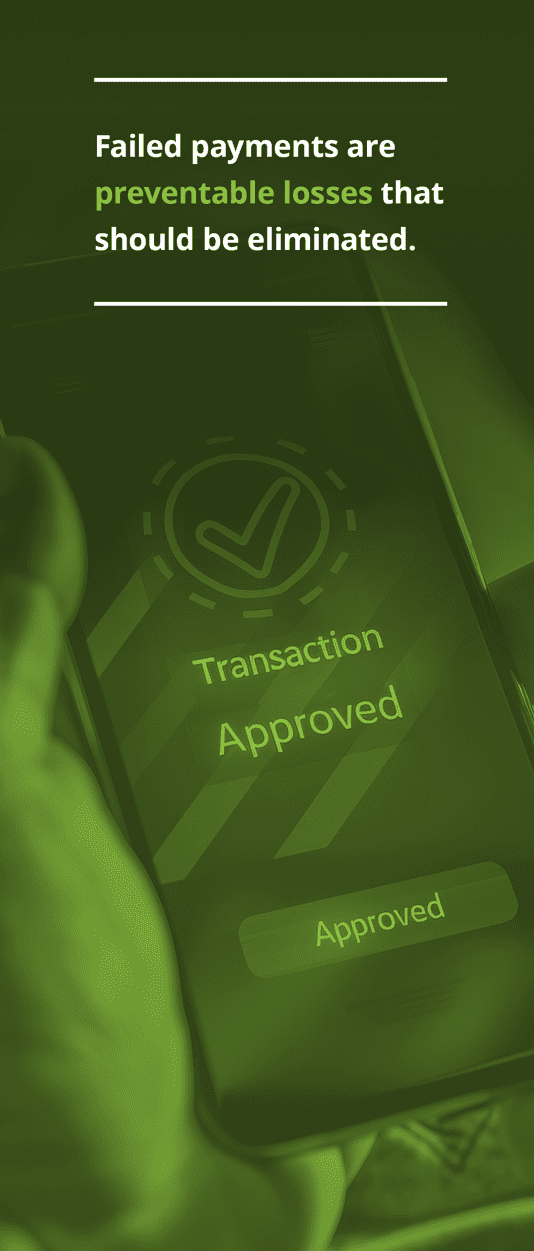Modernizing Payments: A Roadmap from Recovery to Prevention
Introduction: Why Recovery Isn’t Enough Anymore
For years, failed payments have been seen as a behind-the scenes
billing problem—an unfortunate but expected hiccup that
companies would address after the fact. According to findings in
a study by PYMNTS and Nuvei, 11% of transactions processed
by the average eCommerce firm failed in the past year, while
false declines put $157 billion at risk in the United States alone in
2023, with an estimated $81 billion ultimately lost.
To recapture lost revenue, many businesses have leaned heavily
on dunning emails, card update prompts, and standard retry
attempts. While these tactics may help recover some payments,
the environment in which companies operate today has changed
dramatically.
Customer acquisition costs continue to climb, consumers have
higher expectations than ever, and brand loyalty is increasingly
hard to secure. In this landscape, a failed payment is no
longer a small setback—it can jeopardize the entire customer
relationship. Each failure increases pressure on support teams,
drives up churn, and diminishes lifetime value (LTV), all because
a transaction didn’t succeed the first time.
Recovery alone is no longer enough, however. Leading
subscription and eCommerce businesses are shifting to a more
proactive approach and modernizing their payment systems
to optimize transaction success before failures occur. This shift
doesn’t just reduce friction; it improves revenue predictability,
strengthens customer retention, and decreases operational strain.
This guide introduces a practical framework to help businesses
evolve their payment operations from reactive to preventative.
We’ll walk through the three stages of payment system maturity
and provide a roadmap to help you assess your current position,
and outline the steps needed to reach a more resilient future.

Plugging the leaky revenue hole

At the earliest stage of payment maturity, most businesses operate
reactively. When a payment fails, the response usually includes sending
a series of dunning emails, relying on automated retries set by default
platform logic, and depending on manual outreach from support or sales
to re-engage the customer.
The focus here is on plugging the hole after revenue has already started to
leak. Companies at this stage typically track basic metrics such as recovery
rate, chargeback rate, and dunning email engagement (opens and clicks).
These metrics can provide some insight into the effectiveness of recovery
efforts, but they often fall short of showing the full impact on the business.
The prevailing mindset is: “We’ll fix it after it fails.” Unfortunately, this approach often leads to missed opportunities and customer dissatisfaction. Many soft declines— those caused by insufficient funds or temporary holds—go unresolved, resulting in avoidable churn.
Even worse, the overall customer experience suffers, eroding trust and making it harder to win back loyalty.
Making the Recovery Process Smarter
In the second stage of evolution, businesses begin to enhance their recovery efforts by becoming more strategic. Rather than relying solely on default retry logic, companies start experimenting with customized retry schedules—adjusting timing, frequency, and sequencing to better align with customer behavior. Many also begin A/B testing their dunning emails to refine subject lines, send times, and messaging in an effort to boost engagement and payment resolution rates.
At this point, businesses start analyzing why payments are failing by digging into issuer response codes or platform data. They also equip support teams with better tools and training, so they can handle billing related inquiries more efficiently and empathetically.
Metrics become more sophisticated as well. Businesses track retry success rates, email conversion rates (such as completed card updates), and customer churn following failed payments. These data points help companies fine-tune their processes and improve performance over time.
Still, despite these improvements, the approach remains reactive. All efforts are triggered by failure, and results are limited by that. Without addressing the causes of payment failure, even the most optimized recovery process will eventually hit a ceiling.


Hooked on Phonics, a popular e-learning provider, knew that subscriber retention was key to long-term growth. But they were struggling with involuntary churn caused by failed payments.
Here’s what was happening:
• Their internal recovery system was only able to recover 14% of failed transactions.
• The company wanted to improve results and improve retention.
At first, Hooked on Phonics only sent FlexPay the transactions that had already failed 10 times through their in-house recovery system. The company assumed these customers had likely churned on purpose and wouldn’t be recoverable.
But FlexPay’s results surprised them:
• An extra 10% of failed payments were recovered
• These recovered customers had similar lifetime value (LTV) to subscribers whose
payments had never failed
Encouraged by the results, the Hooked on Phonics team decided to adjust their process. Instead of waiting for 10 retries, they sent failed transactions to FlexPay after just 2 internal attempts, and they set a clear goal: an 18% recovery rate to break even after factoring in FlexPay’s fees.
After only one month:
• FlexPay was recovering 45% more failed payments than the internal system alone
• That meant FlexPay outperformed their break-even target by 150%
Timing matters. By handing off failed payments to FlexPay earlier in the process, Hooked on Phonics retained more customers, extended LTV,
and achieved significantly stronger ROI.
Payment Performance Metrics: Prevention vs. Recovery
Prevention Metrics
First-Attempt Authorization Rate (FAR)
What it is: The percentage of transactions approved on the first attempt.
Why it matters: A high FAR = smoother customer experience and fewer downstream recovery costs.
Approval Rate (Total Authorization Rate)
What it is: The percentage of attempted transactions that are ultimately approved, including retries.
Why it matters: Indicates overall payment system effectiveness but may mask retry dependency.
Decline Rate
What it is: The percentage of transactions declined by the issuer or processor.
Why it matters: High decline rates hurt revenue and may signal data quality or fraud issues.
False Decline Rate
What it is: Legitimate transactions incorrectly declined by issuers.
Why it matters: Drives unnecessary churn and lost revenue—especially in fraud-sensitive industries.
Involuntary Churn Rate
What it is: The percentage of customers lost due to payment failure rather than a voluntary cancellation.
Why it matters: It’s often preventable. A hidden revenue leak many businesses overlook.
Net Revenue Retention (NRR)
What it is: Measures revenue growth/loss from existing customers after churn and upgrades/downgrades.
Why it matters: Involuntary churn directly pulls this number down.
Support Ticket Volume Related to Payments
What it is: Number of customer service requests tied to billing or failed transactions.
Why it matters: High volume = poor payment experience = cost burden.
Billing Data Hygiene Score
What it is: Measure of completeness and correctness of stored payment data (e.g., missing ZIP codes,
expired cards).
Why it matters: Clean data improves approval rates and reduces preventable failures.
Chargeback Rate
What it is: Percentage of transactions that are disputed and reversed by the customer.
Why it matters: Impacts merchant standing with processors and can lead to penalties or increased fees.
Recovery Metrics
Recovery Rate
What it is: The percentage of failed payments successfully recovered through retries, dunning, or outreach.
Why it matters: Measures the effectiveness of post-failure strategies.
Retry Success Rate
What it is: Percentage of transactions that succeed on the second or subsequent attempt.
Why it matters: Helps refine retry logic (timing, frequency, method).
Dunning Engagement Rate
What it is: Open, click, or conversion rates on post-failure recovery emails.
Why it matters: Indicates how responsive customers are to recovery efforts.
Revenue at Risk
What it is: The dollar value tied to transactions that failed or are in retry flows.
Why it matters: Shows the potential revenue loss due to failed payments.
Recovered Revenue
What it is: Total revenue successfully recovered after payment failure.
Why it matters: Quantifies the ROI of recovery workflows or tools.

Engineering Success From the Start
The third and most advanced stage represents a strategic shift toward proactive payment success. Rather than waiting for failures to happen, prevention-first businesses build systems designed to maximize approval rates from the outset.
This proactive approach includes optimizing first-attempt authorization through smarter transaction logic, predictive modeling, and high-quality payment data. Advanced companies use specialized tools to analyze historical performance and determine the best time to process transactions and use that insight to guide routing decisions. These companies prioritize clean, complete billing data and invest in reducing technical errors and preventable declines.
Equally important, they foster collaboration across departments. Fraud prevention, billing, product, and customer experience teams work together to reduce friction and increase transaction success. Instead of siloed efforts, there’s a shared commitment to payment success as a strategic priority.
As a result, key metrics shift toward leading indicators of success. Companies begin tracking first-attempt authorization rate (FAR), preventable decline volume, LTV retention, and support ticket volume related to billing. Because fewer payments fail, the customer experience improves, and operational costs decrease.
Modernization Checklist: Where Are You Today?
Not sure where your business stands on the roadmap? Use this quick self-assessment to find out. Check Yes or No for each statement:


The Shift in Motion: Get Started Now
Shifting from recovery to prevention isn’t about layering on more tools; it’s about rethinking how payments fit into your revenue strategy. Here are
three actionable steps to start today:
Audit Your Data & Processes
• Identify the top drivers of payment failure (e.g., expired cards, false declines, insufficient funds).
• Benchmark your current first-attempt authorization rate and involuntary churn rate.
• Review data hygiene practices (billing information completeness, card updater usage).
Build a Cross-Functional Payment Team
• Bring together finance, customer experience, fraud, and revenue operations teams to own payment success jointly.
• Set shared KPIs (e.g., first-attempt approval rate, billing-related support ticket volume) so payments aren’t seen as “just a billing problem.”
Invest in Prevention Tactics
• Improve billing data hygiene, implement smart retry logic, and adopt card updater services.
• Introduce regular reporting on preventable declines and customer experience impacts.
Equally important is a cultural shift. Businesses must move away from accepting payment failures as inevitable and instead treat them as signals that something in the system needs improvement.

Conclusion: A Smarter Path Forward
In today’s environment of rising acquisition costs and shrinking attention spans, businesses that can’t process payments reliably will struggle to scale. Modernizing your payment system begins by assessing where you are today and identifying small wins that reduce failure volume. By committing to building a smarter, more resilient payment experience, you’ll prevent lost revenue and support growth.
Recovery will always play a role, of course, but it should be the safety net, not your primary growth strategy. Improving your authorization optimization is the new growth mindset. The future belongs to businesses that need recovery less often because their systems are built to succeed the first time. By
focusing on first-time payment success, these proactive companies are not only reducing friction but also improving revenue predictability, boosting customer retention, and easing the burden on support and operations teams.
Because in the new era of payments, prevention isn’t just possible, it’s essential.

